steering wheel VOLVO XC60 TWIN ENGINE 2019 Owners Manual
[x] Cancel search | Manufacturer: VOLVO, Model Year: 2019, Model line: XC60 TWIN ENGINE, Model: VOLVO XC60 TWIN ENGINE 2019Pages: 695, PDF Size: 14.96 MB
Page 7 of 695
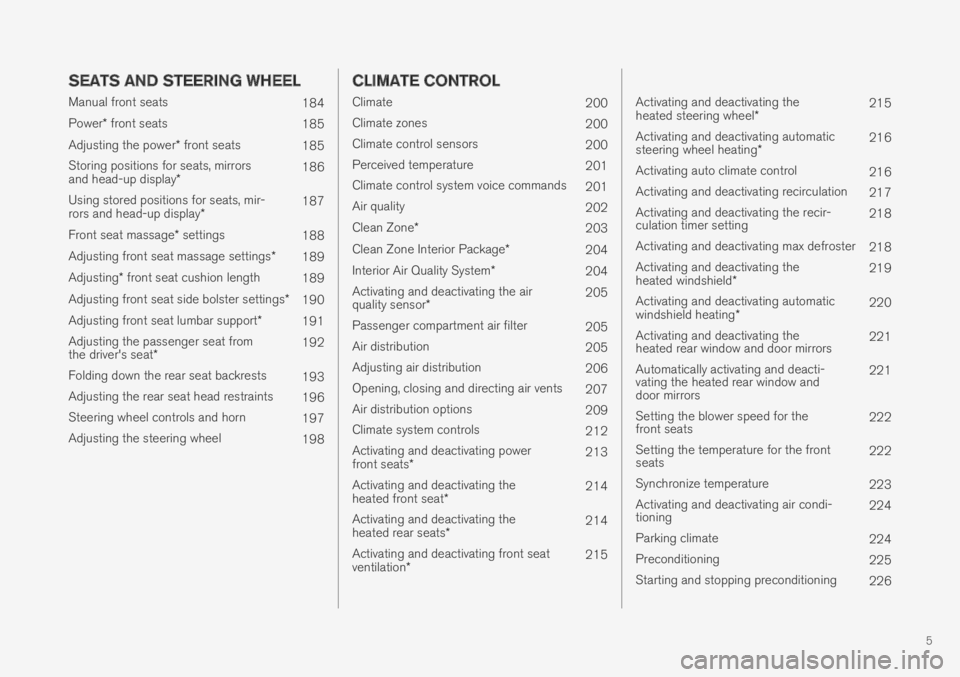
5
SEATS AND STEERING WHEEL
Manual front seats184
Power* front seats185
Adjusting the power* front seats185
Storing positions for seats, mirrorsand head-up display*186
Using stored positions for seats, mir-rors and head-up display*187
Front seat massage* settings188
Adjusting front seat massage settings*189
Adjusting* front seat cushion length189
Adjusting front seat side bolster settings*190
Adjusting front seat lumbar support*191
Adjusting the passenger seat fromthe driver's seat*192
Folding down the rear seat backrests193
Adjusting the rear seat head restraints196
Steering wheel controls and horn197
Adjusting the steering wheel198
CLIMATE CONTROL
Climate200
Climate zones200
Climate control sensors200
Perceived temperature201
Climate control system voice commands201
Air quality202
Clean Zone*203
Clean Zone Interior Package*204
Interior Air Quality System*204
Activating and deactivating the airquality sensor*205
Passenger compartment air filter205
Air distribution205
Adjusting air distribution206
Opening, closing and directing air vents207
Air distribution options209
Climate system controls212
Activating and deactivating powerfront seats*213
Activating and deactivating theheated front seat*214
Activating and deactivating theheated rear seats*214
Activating and deactivating front seatventilation*215
Activating and deactivating theheated steering wheel*215
Activating and deactivating automaticsteering wheel heating*216
Activating auto climate control216
Activating and deactivating recirculation217
Activating and deactivating the recir-culation timer setting218
Activating and deactivating max defroster218
Activating and deactivating theheated windshield*219
Activating and deactivating automaticwindshield heating*220
Activating and deactivating theheated rear window and door mirrors221
Automatically activating and deacti-vating the heated rear window anddoor mirrors
221
Setting the blower speed for thefront seats222
Setting the temperature for the frontseats222
Synchronize temperature223
Activating and deactivating air condi-tioning224
Parking climate224
Preconditioning225
Starting and stopping preconditioning226
Page 9 of 695
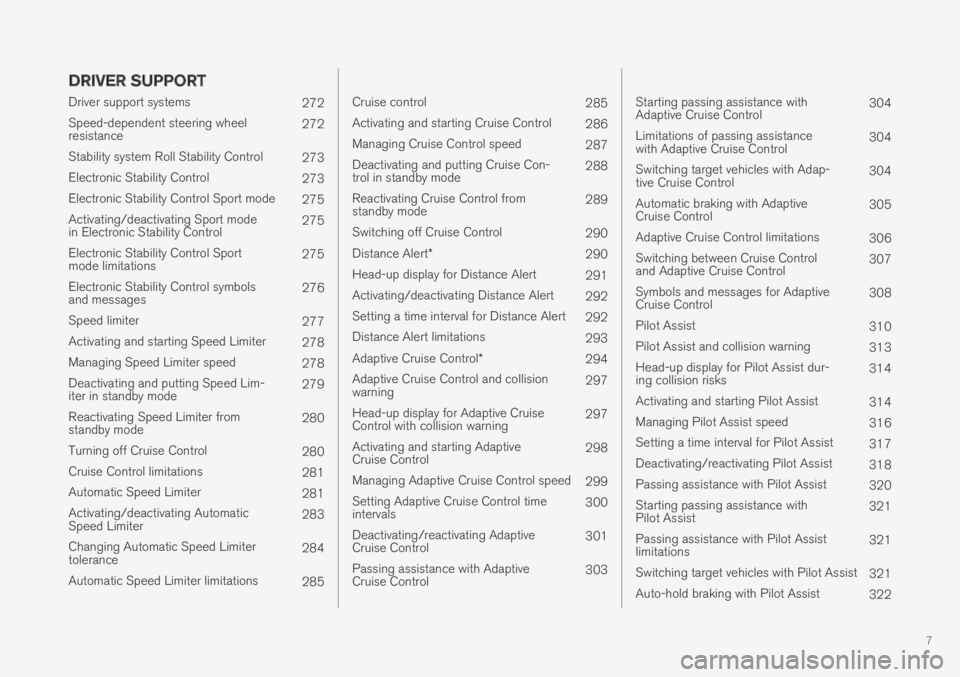
7
DRIVER SUPPORT
Driver support systems272
Speed-dependent steering wheelresistance272
Stability system Roll Stability Control273
Electronic Stability Control273
Electronic Stability Control Sport mode275
Activating/deactivating Sport modein Electronic Stability Control275
Electronic Stability Control Sportmode limitations275
Electronic Stability Control symbolsand messages276
Speed limiter277
Activating and starting Speed Limiter278
Managing Speed Limiter speed278
Deactivating and putting Speed Lim-iter in standby mode279
Reactivating Speed Limiter fromstandby mode280
Turning off Cruise Control280
Cruise Control limitations281
Automatic Speed Limiter281
Activating/deactivating AutomaticSpeed Limiter283
Changing Automatic Speed Limitertolerance284
Automatic Speed Limiter limitations285
Cruise control285
Activating and starting Cruise Control286
Managing Cruise Control speed287
Deactivating and putting Cruise Con-trol in standby mode288
Reactivating Cruise Control fromstandby mode289
Switching off Cruise Control290
Distance Alert*290
Head-up display for Distance Alert291
Activating/deactivating Distance Alert292
Setting a time interval for Distance Alert292
Distance Alert limitations293
Adaptive Cruise Control*294
Adaptive Cruise Control and collisionwarning297
Head-up display for Adaptive CruiseControl with collision warning297
Activating and starting AdaptiveCruise Control298
Managing Adaptive Cruise Control speed299
Setting Adaptive Cruise Control timeintervals300
Deactivating/reactivating AdaptiveCruise Control301
Passing assistance with AdaptiveCruise Control303
Starting passing assistance withAdaptive Cruise Control304
Limitations of passing assistancewith Adaptive Cruise Control304
Switching target vehicles with Adap-tive Cruise Control304
Automatic braking with AdaptiveCruise Control305
Adaptive Cruise Control limitations306
Switching between Cruise Controland Adaptive Cruise Control307
Symbols and messages for AdaptiveCruise Control308
Pilot Assist310
Pilot Assist and collision warning313
Head-up display for Pilot Assist dur-ing collision risks314
Activating and starting Pilot Assist314
Managing Pilot Assist speed316
Setting a time interval for Pilot Assist317
Deactivating/reactivating Pilot Assist318
Passing assistance with Pilot Assist320
Starting passing assistance withPilot Assist321
Passing assistance with Pilot Assistlimitations321
Switching target vehicles with Pilot Assist321
Auto-hold braking with Pilot Assist322
Page 12 of 695
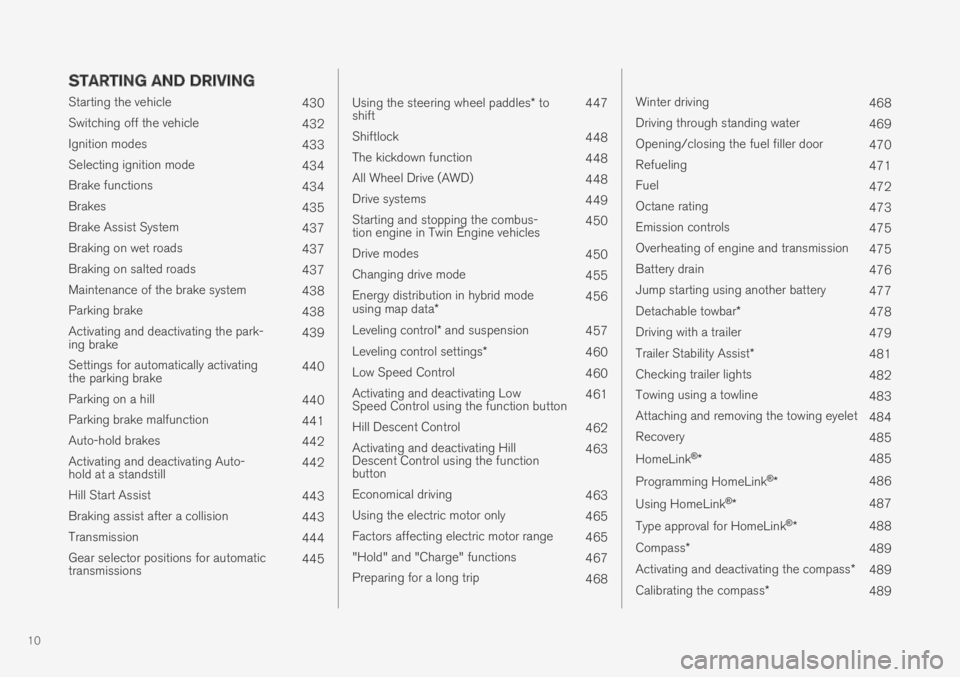
10
STARTING AND DRIVING
Starting the vehicle430
Switching off the vehicle432
Ignition modes433
Selecting ignition mode434
Brake functions434
Brakes435
Brake Assist System437
Braking on wet roads437
Braking on salted roads437
Maintenance of the brake system438
Parking brake438
Activating and deactivating the park-ing brake439
Settings for automatically activatingthe parking brake440
Parking on a hill440
Parking brake malfunction441
Auto-hold brakes442
Activating and deactivating Auto-hold at a standstill442
Hill Start Assist443
Braking assist after a collision443
Transmission444
Gear selector positions for automatictransmissions445
Using the steering wheel paddles* toshift447
Shiftlock448
The kickdown function448
All Wheel Drive (AWD)448
Drive systems449
Starting and stopping the combus-tion engine in Twin Engine vehicles450
Drive modes450
Changing drive mode455
Energy distribution in hybrid modeusing map data*456
Leveling control* and suspension457
Leveling control settings*460
Low Speed Control460
Activating and deactivating LowSpeed Control using the function button461
Hill Descent Control462
Activating and deactivating HillDescent Control using the functionbutton
463
Economical driving463
Using the electric motor only465
Factors affecting electric motor range465
"Hold" and "Charge" functions467
Preparing for a long trip468
Winter driving468
Driving through standing water469
Opening/closing the fuel filler door470
Refueling471
Fuel472
Octane rating473
Emission controls475
Overheating of engine and transmission475
Battery drain476
Jump starting using another battery477
Detachable towbar*478
Driving with a trailer479
Trailer Stability Assist*481
Checking trailer lights482
Towing using a towline483
Attaching and removing the towing eyelet484
Recovery485
HomeLink®*485
Programming HomeLink®*486
Using HomeLink®*487
Type approval for HomeLink®*488
Compass*489
Activating and deactivating the compass*489
Calibrating the compass*489
Page 15 of 695
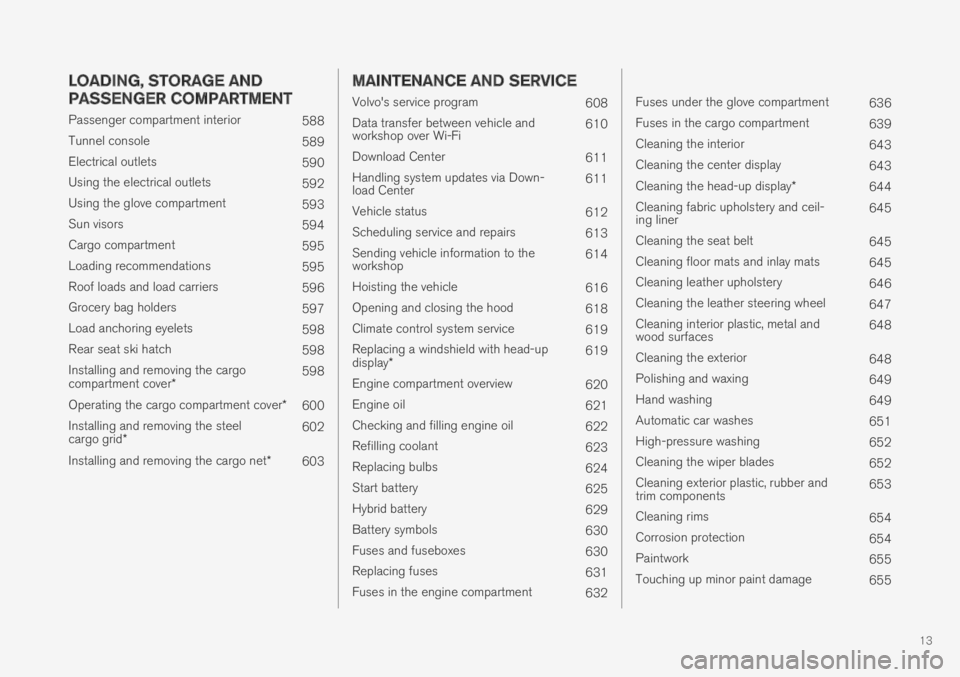
13
LOADING, STORAGE AND
PASSENGER COMPARTMENT
Passenger compartment interior588
Tunnel console589
Electrical outlets590
Using the electrical outlets592
Using the glove compartment593
Sun visors594
Cargo compartment595
Loading recommendations595
Roof loads and load carriers596
Grocery bag holders597
Load anchoring eyelets598
Rear seat ski hatch598
Installing and removing the cargocompartment cover*598
Operating the cargo compartment cover*600
Installing and removing the steelcargo grid*602
Installing and removing the cargo net*603
MAINTENANCE AND SERVICE
Volvo's service program608
Data transfer between vehicle andworkshop over Wi-Fi610
Download Center611
Handling system updates via Down-load Center611
Vehicle status612
Scheduling service and repairs613
Sending vehicle information to theworkshop614
Hoisting the vehicle616
Opening and closing the hood618
Climate control system service619
Replacing a windshield with head-updisplay*619
Engine compartment overview620
Engine oil621
Checking and filling engine oil622
Refilling coolant623
Replacing bulbs624
Start battery625
Hybrid battery629
Battery symbols630
Fuses and fuseboxes630
Replacing fuses631
Fuses in the engine compartment632
Fuses under the glove compartment636
Fuses in the cargo compartment639
Cleaning the interior643
Cleaning the center display643
Cleaning the head-up display*644
Cleaning fabric upholstery and ceil-ing liner645
Cleaning the seat belt645
Cleaning floor mats and inlay mats645
Cleaning leather upholstery646
Cleaning the leather steering wheel647
Cleaning interior plastic, metal andwood surfaces648
Cleaning the exterior648
Polishing and waxing649
Hand washing649
Automatic car washes651
High-pressure washing652
Cleaning the wiper blades652
Cleaning exterior plastic, rubber andtrim components653
Cleaning rims654
Corrosion protection654
Paintwork655
Touching up minor paint damage655
Page 30 of 695

||
YOUR VOLVO
* Option/accessory.28
goal. In addition to continuous environmentalrefinement of conventional gasoline-poweredinternal combustion engines, Volvo is activelylooking at advanced technology alternative-fuelvehicles.
When you drive a Volvo, you become our partnerin the work to lessen the vehicle's impact on theenvironment. To reduce your vehicle's environ-mental impact, you can:
Maintain proper air pressure in your tires.Tests have shown decreased fuel economywith improperly inflated tires.
Follow the recommended maintenanceschedule in your Warranty and ServiceRecords Information booklet.
Drive at a constant speed whenever possible.
See a trained and qualified Volvo servicetechnician as soon as possible for inspectionif the check engine (malfunction indicator)light illuminates, or stays on after the vehiclehas started.
Properly dispose of any vehicle-related wastesuch as used motor oil, used batteries, brakepads, etc.
When cleaning your vehicle, please use gen-uine Volvo car care products. All Volvo carcare products are formulated to be environ-mentally friendly.
Twin Engine vehicles
If possible, precondition the vehicle with thecharging cable before driving.
If preconditioning is not possible in coldweather, use the seat and steering wheelheating primarily. Avoid heating the entirepassenger compartment, which reduces thehybrid battery's charge level.
Choose the Pure drive mode to help mini-mize electric power consumption.
In hilly terrain, put the gear selector in modeB to utilize the electric motor's braking func-tion when the accelerator pedal is released.This helps charge the hybrid battery.
Related information
Economical driving (p. 463)
Starting and stopping preconditioning(p. 226)
The Owner's Manual and the environment(p. 24)
Air quality (p. 202)
IntelliSafe - driver support
IntelliSafe is Volvo Cars' philosophy regardingvehicle safety. IntelliSafe consists of a number ofsystems, both standard and optional, that aredesigned to help make driving safer, preventaccidents and protect passengers and otherroad users.
Support
IntelliSafe includes driver support functions suchas Adaptive cruise control* which helps the driverto maintain an even speed combined with a pre-selected time interval to the vehicle ahead.
Pilot Assist2 helps the driver keep the vehicle inthe current traffic lane by providing steeringassistance and maintaining an even speed and aset time interval to the vehicle ahead.
Park Assist Pilot* helps the driver pull into andout of parking spaces.
Other examples of systems that can help thedriver are the Active main beam, Cross TrafficAlert (CTA)* and Blind Spot Information (BLIS)*systems.
Prevention
City Safety is a function intended to help preventaccidents. The function can help prevent or miti-gate a collision with pedestrians, cyclists, largeanimals or other vehicles. Light, sound and pulsa-tions in the brake pedal are provided to alert of a
2Depending on market, this function can be either standard or optional.
Page 33 of 695

YOUR VOLVO
}}
* Option/accessory.31
Different types of information are shown in different displays depending on how the information should be prioritized.
Head-up display *
The head-up display presents information thatthe driver should react to immediately.For example, traffic warnings, speed information
and navigation messages*. Road sign informationand incoming phone calls are also shown in thehead-up display. These can be handled using theright-side steering wheel keypad or the centerdisplay.
Instrument panel
The instrument panel displays informationsuch as speed, incoming phone calls or the track
Page 45 of 695

SAFETY
}}
* Option/accessory.43
Safety during pregnancy
It is important that seat belts are worn correctlyduring pregnancy and that pregnant driversadjust their seating position accordingly.
Seat belt
The seat belt should fit closely against the shoul-der, with the diagonal section between thebreasts and to the side of the stomach.
The lap section of the seat belt should lie flatover the thighs and as far as possible under thestomach. Never let it ride upward. Removeunnecessary slack and make sure the seat beltfits as close as possible to the body. Make surethere are no twists in the seat belt.
Seating position
As pregnancy progresses, pregnant driversshould adjust the seat and steering wheel to aposition that allows them to retain full control of
the vehicle (which means they should be able toeasily reach the steering wheel and foot pedals).Try to maintain as much distance as possiblebetween the stomach and the steering wheel.
Related information
Safety (p. 42)
Seat belts (p. 47)
Manual front seats (p. 184)
Power* front seats (p. 185)
Occupant safety
Safety is Volvo's cornerstone.
Volvo's concern for safety
Our concern for safety dates back to 1927 whenthe first Volvo rolled off the production line.Three-point seat belts (a Volvo invention), safetycages, and energy-absorbing impact zones weredesigned into Volvo vehicles long before it wasfashionable or required by government regulation.
We will not compromise our commitment tosafety. We continue to seek out new safety fea-tures and to refine those already in our vehicles.You can help. We would appreciate hearing yoursuggestions about improving automobile safety.We also want to know if you ever have a safetyconcern with your vehicle. Call us in the U.S. at:1-800-458-1552 or in Canada at:1-800-663-8255.
Page 53 of 695
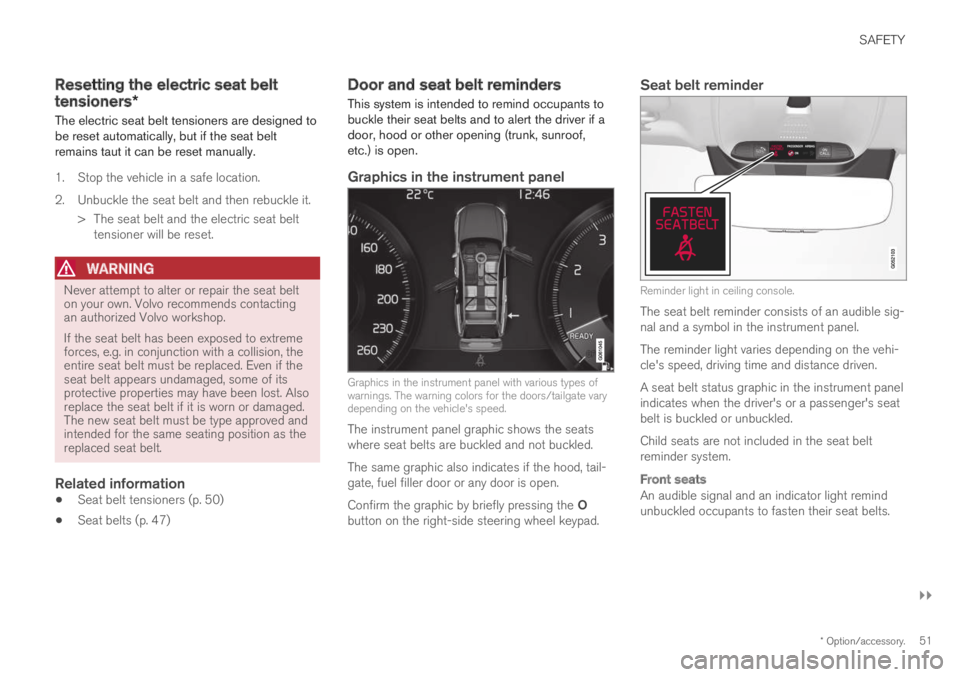
SAFETY
}}
* Option/accessory.51
Resetting the electric seat belt
tensioners*
The electric seat belt tensioners are designed tobe reset automatically, but if the seat beltremains taut it can be reset manually.
1. Stop the vehicle in a safe location.
2.Unbuckle the seat belt and then rebuckle it.
> The seat belt and the electric seat belttensioner will be reset.
WARNING
Never attempt to alter or repair the seat belton your own. Volvo recommends contactingan authorized Volvo workshop.
If the seat belt has been exposed to extremeforces, e.g. in conjunction with a collision, theentire seat belt must be replaced. Even if theseat belt appears undamaged, some of itsprotective properties may have been lost. Alsoreplace the seat belt if it is worn or damaged.The new seat belt must be type approved andintended for the same seating position as thereplaced seat belt.
Related information
Seat belt tensioners (p. 50)
Seat belts (p. 47)
Door and seat belt reminders
This system is intended to remind occupants tobuckle their seat belts and to alert the driver if adoor, hood or other opening (trunk, sunroof,etc.) is open.
Graphics in the instrument panel
Graphics in the instrument panel with various types ofwarnings. The warning colors for the doors/tailgate varydepending on the vehicle's speed.
The instrument panel graphic shows the seatswhere seat belts are buckled and not buckled.
The same graphic also indicates if the hood, tail-gate, fuel filler door or any door is open.
Confirm the graphic by briefly pressing the Obutton on the right-side steering wheel keypad.
Seat belt reminder
Reminder light in ceiling console.
The seat belt reminder consists of an audible sig-nal and a symbol in the instrument panel.
The reminder light varies depending on the vehi-cle's speed, driving time and distance driven.
A seat belt status graphic in the instrument panelindicates when the driver's or a passenger's seatbelt is buckled or unbuckled.
Child seats are not included in the seat beltreminder system.
Front seats
An audible signal and an indicator light remindunbuckled occupants to fasten their seat belts.
Page 55 of 695

SAFETY
}}
53
Driver/passenger-side airbags
As a supplement to the seat belts, the vehicle isequipped with driver and passenger side frontairbags.
Driver/passenger side front airbags.
In a frontal collision, the airbags help protect thedriver's and passenger's head, face and chestand the driver's knees and legs.
A collision of a sufficiently violent force will trig-ger the sensors and one or more airbags willinflate. The airbag helps cushion the initial impactof the collision for the passenger. The airbagdeflates when compressed by the collision. Asmall amount of powder will also be releasedfrom the airbag. This may appear to be smokeand is normal. The entire process, from inflationto deflation of the airbag, occurs within tenths ofa second.
NOTE
The sensors react differently depending onthe circumstances of the accident andwhether or not the seat belt is used. Does notapply to all belt positions.
In some accident situations, only one (ornone) of the airbags will be deployed. Thesensors monitor the impact of the collisionand react accordingly to deploy one, severalor no airbags.
WARNING
The seat belt and the airbag work together. Ifthe seat belt is not used or is used incorrectly,the airbag may not provide the intended pro-tection in a collision.
To help prevent injury in the event the airbagis deployed, passengers should sit as uprightas possible, with their feet on the floor andtheir backs against the seat backrest.
WARNING
Volvo recommends contacting an authorizedVolvo workshop for repairs. Incorrectly per-formed repairs to the airbag system couldimpair function and lead to serious injury.
The front airbag system
The front airbag system includes gas generatorssurrounded by the airbags, and deceleration sen-
sors that activate the gas generators, causing theairbags to be inflated with nitrogen gas.
As the movement of the seats' occupants com-presses the airbags, some of the gas is expelledat a controlled rate to provide better cushioning.The belt tensioners minimize slack in the seatbelts and are activated for occupants wearingtheir seat belts. The entire process, from inflationto deflation of the airbag, occurs within tenths ofa second.
The location of the front airbags is indicated bySRS AIRBAG embossed on the steering wheelpad and above the glove compartment, and bydecals on both sun visors and on the front andfar right side of the dash.
The driver's side front airbag is folded andlocated in the steering wheel hub.
The knee airbag is folded on the underside ofthe dashboard on the driver's side. The textAIRBAG is embossed on the panel.
The passenger's side front airbag is foldedbehind a panel located above the glove compart-ment.
Page 58 of 695
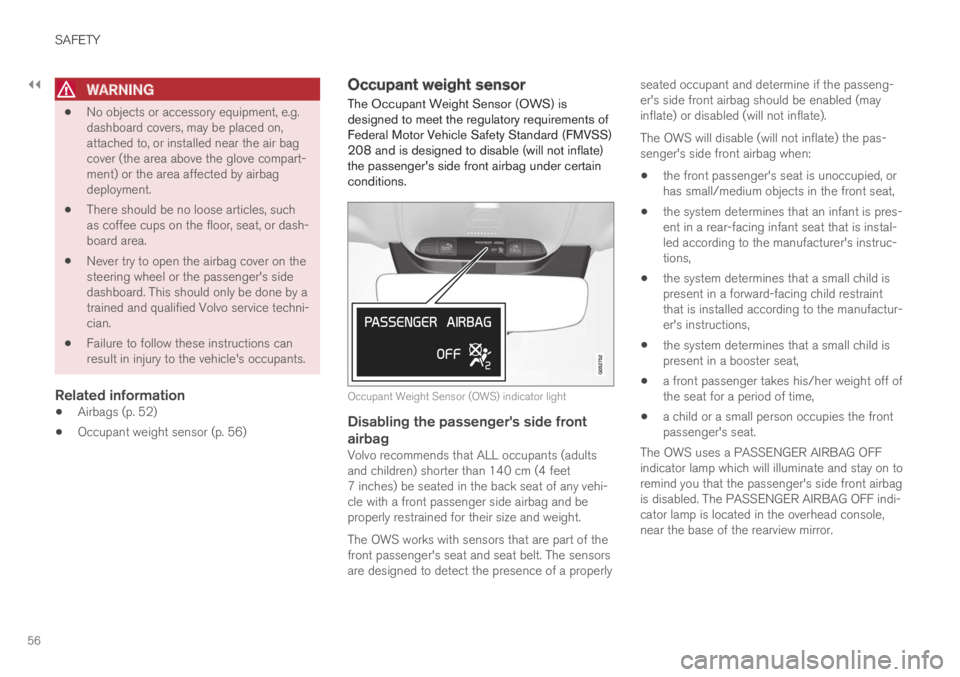
||
SAFETY
56
WARNING
No objects or accessory equipment, e.g.dashboard covers, may be placed on,attached to, or installed near the air bagcover (the area above the glove compart-ment) or the area affected by airbagdeployment.
There should be no loose articles, suchas coffee cups on the floor, seat, or dash-board area.
Never try to open the airbag cover on thesteering wheel or the passenger's sidedashboard. This should only be done by atrained and qualified Volvo service techni-cian.
Failure to follow these instructions canresult in injury to the vehicle's occupants.
Related information
Airbags (p. 52)
Occupant weight sensor (p. 56)
Occupant weight sensor
The Occupant Weight Sensor (OWS) isdesigned to meet the regulatory requirements ofFederal Motor Vehicle Safety Standard (FMVSS)208 and is designed to disable (will not inflate)the passenger's side front airbag under certainconditions.
Occupant Weight Sensor (OWS) indicator light
Disabling the passenger's side front
airbag
Volvo recommends that ALL occupants (adultsand children) shorter than 140 cm (4 feet7 inches) be seated in the back seat of any vehi-cle with a front passenger side airbag and beproperly restrained for their size and weight.
The OWS works with sensors that are part of thefront passenger's seat and seat belt. The sensorsare designed to detect the presence of a properly
seated occupant and determine if the passeng-er's side front airbag should be enabled (mayinflate) or disabled (will not inflate).
The OWS will disable (will not inflate) the pas-senger's side front airbag when:
the front passenger's seat is unoccupied, orhas small/medium objects in the front seat,
the system determines that an infant is pres-ent in a rear-facing infant seat that is instal-led according to the manufacturer's instruc-tions,
the system determines that a small child ispresent in a forward-facing child restraintthat is installed according to the manufactur-er's instructions,
the system determines that a small child ispresent in a booster seat,
a front passenger takes his/her weight off ofthe seat for a period of time,
a child or a small person occupies the frontpassenger's seat.
The OWS uses a PASSENGER AIRBAG OFFindicator lamp which will illuminate and stay on toremind you that the passenger's side front airbagis disabled. The PASSENGER AIRBAG OFF indi-cator lamp is located in the overhead console,near the base of the rearview mirror.